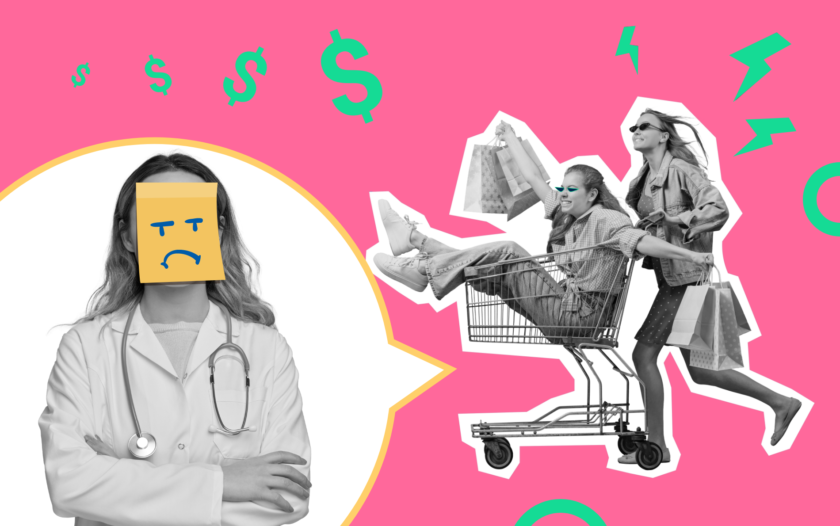What a Psychologist Says You Should Do if you Are an Emotional Spender
About Anouare
Anouare is a seasoned writer, editor and content strategist who started her career as a lifestyle journalist before stepping into leadership roles at publications such as AskMen and Goalcast. From editorial strategy to content marketing and project-management, she has tackled various challenges in digital media and discovered her passion for mentoring others in the process. She loves a good money mindset book and believes you can create your dream lifestyle by being yourself.
Read full bio
At a Glance
Do you struggle with emotional spending? A psychologist shares what you need to understand about the habit and how you can manage your tendencies.
People joke about retail therapy, but emotional spending is a serious issue. And if you often make yourself feel better by adding things to your cart and clicking on that Buy Now, Pay Later button, you may want to reconsider your relationship to spending.
“Emotional spending describes a behavioral pattern of purchasing in response to an emotion while ignoring one’s financial budget, means, money values, and actual needs,” says licensed clinical psychologist Dr. Jamie Long
According to her, emotional spenders may engage in frequent episodes of shopping that feel out of control, often spending money past the point of their actual budget.
Signs that you are an emotional spender
Just because you splurge on an impulse purchase every once in a while doesn’t make you an emotional spender. There is an array of signs to look out for, according to Long:
- Impulsive purchases, not taking time to discern if an item is needed versus just wanting it in the moment
- Obsessively thinking about things to purchase
- Making purchases without considering one’s budget
- Feeling embarrassed by purchases, hiding purchases from loved ones
- Being surprised by bills and financial statements
- Not understanding where money is going; expecting more money to be in an account
- Feeling guilty after purchasing something
- Not remembering what one ordered; being surprised by a package(s)
- Spending more time than intended shopping online
Even responsible and financially savvy shoppers can develop an issue with emotional spending. It can creep up on you. “As an owner of a small business, spending money wisely is one of my priorities. However, a couple years ago, I was in a downward spiral of emotional spending,” shares Brian Campbell, founder and CEO of WaterFilterGuru.
“It started slow. I was accustomed to buying myself a bar of chocolate or a cup of coffee from the corner store down the street whenever I felt overwhelmed or stressed. Then, it gradually grew to larger chocolate bars and board games or clothing,” he adds.
“Within a year, my habits grew from a bar of chocolate a week to the point that I was buying items worth $25 and more twice a week! At the moment of purchase, I’d justify it as a one-time thing. I stayed in denial for a long time, which is quite common for people facing an addiction or emotional reliance on any action.”
If emotional spending has put you in a tough financial situation, check out lenders and solutions that will meet your need.
Check out lenders and solutions that will get you what you need

 We found 7 options for your requirement
We found 7 options for your requirement
10.5% - 29.99%
Est. APR Range$5,000 - $40,000
Loan Amount2-5 years
Loan TermGood For: Eliminating high-interest credit card debt
5.35% - 35.99%
Est. APR Range$1,000 - $50,000
Loan Amount3-5 years
Loan TermGood For: Low loan amount
7.99% - 35.99%
Est. APR Range$2,000 - $36,500
Loan Amount2-6 years
Loan TermGood For: Fast funding
8.49% - 35.99%
Est. APR Range$1,000 - $50,000
Loan Amount2-7 years
Loan TermGood For: Low loan amount
8.99% - 35.99%
Est. APR Range$2,000 - $50,000
Loan Amount3-5 years
Loan TermGood For: Getting funds quickly
9.95% - 35.99%
Est. APR Range$2,000 - $35,000
Loan Amount1-5 years
Loan TermGood For: Getting funds quickly
11.69% - 35.99%
Est. APR Range$1,000 - $50,000
Loan Amount3-5 years
Loan TermGood For: low income criteria, fast funds
Congratulations! You’re close to seeing your offers!
Please take a second to review the details you shared earlier
Sorry, we didn’t find any options that meet your requirements. Please try modifying your preferences.
What to do if you’re an emotional spender
If you recognize yourself in the story and signs shared above, consider seeking professional support. Emotional spending is more than a pesky bad habit to kick, even if you can afford it.
“Even for those with financial means, emotional spending can cause problems in relationships due to conflict about how to spend money,” says Long. “Talking to a therapist can lead to better understanding of the cause (such an impulse control issue or mood instability issue). A therapist can help an emotional spender with a treatment plan that includes emotional and behavioral change strategies.”
Even for those with financial means, emotional spending can cause problems in relationships due to conflict about how to spend money.
Campbell experienced a wake-up call when his credit score began to decline. He confided in a loved one, who recommended therapy. “Therapy helped me understand my triggers and develop ways to calm myself down without shopping. When you start recovering from the habit, you soon realize that emotional spending doesn’t do much to make you feel better. You get distracted for a while before you return to the stressful situation, and the cycle repeats,” he says.
“It’s much more sustainable and healthy to build habits that help you manage and combat the stressors in your life.”
Habits to embrace to manage emotional spending
The following habits can help you manage emotional spending, according to Long.
- Remove or limit access to the various ways you can buy things. “For instance, if you’re more likely to make purchases at night while on your phone, put the phone in a bag or a different room during evening hours. Consider blocking certain websites at different times of the day and limit screen time overall,” says Long.
- Make a budget and track expenses. “Many emotional spenders do not have a reliable and systematic process to discern how much money is available for discretionary spending and how much has been spent in a given period of time,” she adds. As an emotional spender, becoming more mindful of your behaviors can help you make purchases that align with your actual goals – it’s kind of the same as keeping a food diary when you want to revamp your eating habits.
- Clarify your money values. “Once you understand how much you’re actually spending in a given period of time, ask yourself, ‘How would I spend X amount of dollars if I had the chance to do it over again?’” recommends Long. “The answer to that question provides clues to your money values – the type of spender (or saver) you want to be. Perhaps you’d spend less money on takeout and go on a restorative vacation, for example.”
- Find healthier ways to cope with your emotions. As an emotional spender, shopping is a way to temporarily distract yourself from your feelings. Practice identifying how you feel and tending to your needs without spending money. For example, if you realize that you’re bored, engage in an interesting activity that doesn’t require making a purchase.
Bottom line
Remember that overcoming the tendency to emotionally spend can take time and continuous effort. Aim for progress, not perfection. “To anyone also struggling: remember that there’s always a way out. The journey of breaking habits like emotional spending is rough – there are days that you’ll fail and fall behind, but it’s okay as long as you get back up and keep trying. Some day, you’ll get there,” says Campbell.
You may also want to take charge of any debt accrued through emotional spending. A tool like this free debt consolidation calculator can help you make the process more manageable and less overwhelming.









